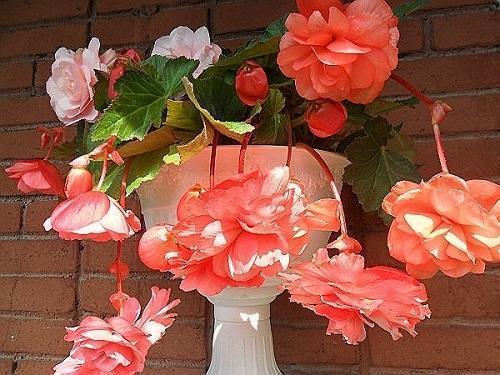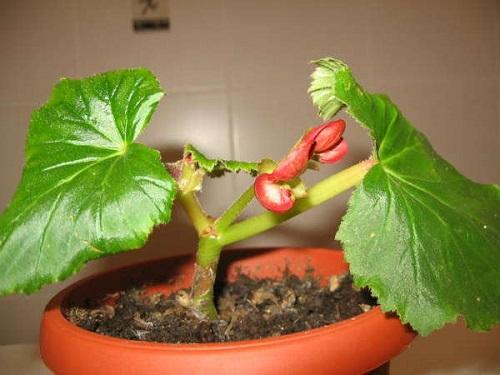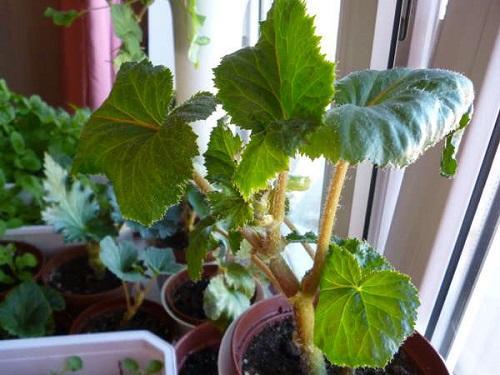Why does begonia not bloom, but gives only foliage?
Begonia attracts attention with unusual lush inflorescences, somewhat reminiscent of the queen of flowers - a rose. Despite the fact that begonia is not very demanding in care, it is necessary to pay a little attention to it to maintain lush flowering. By decorativeness, begonias are divided into deciduous and flowering plants. So, with improper care of a blooming begonia, the plant will only give foliage and move to a decorative look or it will start to hurt. The article will tell you what may be the reason why begonia does not bloom at home, but only gives foliage.

Incorrect identification of the type of plant and too "young" age
As already mentioned, begonias are flowering and decorative. If everything is clear with flowering varieties, then decorative begonias will delight the eye only with unusual leaves. Deciduous varieties are also very beautiful, but if you got into the collection of flowers begonia decorative look, expecting flowering from it is a useless exercise.

Experienced flower growers have long noticed that begonia blooms on its own only after at least 5 rings are formed on the main stem. When buying a young small plant that already has inflorescences, one can suspect that the flowering is caused artificially by the introduction of special stimulating drugs. This means that it will be short and will not be repeated until the begonia reaches the required age.
Lack of lighting
Begonia is a light-loving plant. If the flowerpot on the northern windowsill has stopped blooming, it means that it lacks lighting. To remedy the situation, it is enough to rearrange the pot in a well-lit place, but without fanaticism, since the plant will receive burns from bright sunlight. The ideal solution would be a south-east or south-west window sill.
Low air humidity or improper watering

Dry air has a bad effect on begonia, the leaves begin to dry out at the edges and over time it will completely stop blooming. To increase humidity, you can put a jar of water on the windowsill, or hang a damp towel on the radiator.
And the plant will perfectly respond with flowering to an open aquarium standing next to it.

As for watering, with a shortage of water or an excess of moisture, begonia dies. You can try to save at least a few branches: cut off the still living stems and put them in the water. After rooting, they are planted.
Non-observance of temperature conditions and cold air
In summer, a comfortable temperature for begonias is 22 degrees, and in winter 15 degrees. An increase or decrease in room temperature or sudden fluctuations in it will lead begonia to a stressful state in which flowering is impossible. To prevent this, the pot must be placed in a room with a constant climate.
The reason for refusing to bloom is also the presence of drafts in the begonia's habitat.
Violation of the timing of the rest period
Like every plant, begonias need a dormant period during which they will rest before flowering again.If it was not there at all, or the begonia woke up ahead of time, it will not have enough strength to bloom again. Need help and set a rest schedule. With abundant flowering in winter, the summer three months are left for rest. With the arrival of summer, move the pot to a cool place in the shade with a temperature of no more than 17 degrees and reduce watering. Also, reduce the daylight hours to 7 hours and cover the begonia on top after this time has elapsed.
To bring the flower out of hibernation also gradually - to increase the duration of daylight hours and watering, to increase the temperature regime.
Lack or excess of vitamins and fertilizers
If begonias do not have enough vitamins for lush flowering, you need to transplant the plant, completely changing the soil to a special land for planting begonias. If there is no way to transplant a flower into a new soil, it must at least be fed fertilizer... Be careful though, as too much fertilizer will burn the root system or redirect the power of the begonia into growing leaves.
The presence of pests

If you put the indoor begonia outdoors for the summer, it is carefully examined for pests when transported back to the house. If aphids, spider mites and other harmful insects are found that take away the strength necessary for flowering, immediately treat the begonia with special means.
